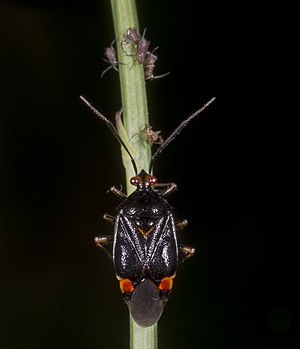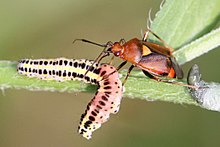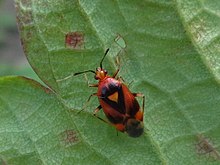Red soft bug
| Red soft bug | ||||||||||||
|---|---|---|---|---|---|---|---|---|---|---|---|---|

Red soft bug (basic black color) with aphids |
||||||||||||
| Systematics | ||||||||||||
|
||||||||||||
| Scientific name | ||||||||||||
| Deraeocoris ruber | ||||||||||||
| ( Linnaeus , 1758) |

The red soft bug ( Deraeocoris ruber ) is a bug from the family of soft bugs (Miridae).
features
The animals are 6.6 to 7.7 millimeters long. Their basic color varies from red-orange to almost completely black. As a rule, the cuneus of the hemielytras is more or less strongly colored red. The males are darker in color than the females.
Occurrence and habitat
The species is distributed throughout Europe (with the exception of the far north), North Africa and further east to the Caucasus . She was also abducted to North and South America and performs locally there. In Central Europe it occurs everywhere and is common, but it is much rarer in the north and in the higher elevations of the low mountain ranges. The herb, shrub and tree layers are colonized, although the species is not restricted to any specific plants. However, they are mainly found on the great nettle ( Urtica dioica ), Rubus species, goat clover ( Cytisus ) and thistles . Deciduous trees, including fruit trees, are preferred on woody plants, but the bugs are only rarely found on coniferous trees such as pine ( Pinus ), larch ( Larix ), arborvitae ( Thuja ) and juniper ( Juniperus ), where tree lice (Lachnidae) live. The species also colonizes forests, but occurs mainly on sunny forest edges and open habitats.
Way of life
The species predatory feeds on various small arthropods such as small caterpillars , but especially on aphids . The prey is quickly killed and sucked out by a sting that is also painful for humans. It is therefore considered a beneficial insect in agriculture. The females lay their eggs in August and September. The hibernation takes place as an egg, from which the red-brown nymphs hatch in May, with prickly reinforced abdomen . The adults appear mainly in July and August and become increasingly rare from the end of September. In the Mediterranean region and possibly also in more temperature-favored places further north, two generations arise per year.
Taxonomy
The species was described by Carl von Linné as Cimex ruber in his work Systema naturae . Today it is placed in the genus Deraeocoris within the soft bug subfamily Deraeocorinae .
supporting documents
Individual evidence
- ↑ a b c d Ekkehard Wachmann , Albert Melber, Jürgen Deckert: Bugs. Volume 2: Cimicomorpha: Microphysidae (lichen bugs), Miridae (soft bugs) (= The animal world of Germany and the adjacent parts of the sea according to their characteristics and their way of life . 75th part). Goecke & Evers, Keltern 2006, ISBN 3-931374-57-2 , p. 43 ff .
- ↑ Deraeocoris ruber. British Bugs, accessed March 10, 2014 .
- Jump up ↑ Linnaeus, C., 1758: Systema naturae per regna tria naturae, secundum classes, ordines, genera, species, cum characteribus, differentiis, synonymis, locis. Editio Decima, Reformata. Tomus I. Laurentii Salvii, Stockholm 1758, p. 446 doi : 10.5962 / bhl.title.542
- ↑ Deraeocoris ruber in Fauna Europaea. Retrieved March 10, 2014
literature
- Ekkehard Wachmann , Albert Melber, Jürgen Deckert: Bugs. Volume 2: Cimicomorpha: Microphysidae (lichen bugs), Miridae (soft bugs) (= The animal world of Germany and the adjacent parts of the sea according to their characteristics and their way of life . 75th part). Goecke & Evers, Keltern 2006, ISBN 3-931374-57-2 .
Web links
- FaunaEuropaea: Deraeocoris (Deraeocoris) ruber (Linnaeus, 1758) - taxonomy, distribution in Europe


